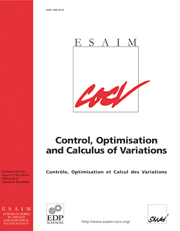Crossref Citations
This article has been cited by the following publications. This list is generated based on data provided by
Crossref.
Antonietti, Paola F.
Borzì, Alfio
and
Verani, Marco
2013.
Multigrid Shape Optimization Governed by Elliptic PDEs.
SIAM Journal on Control and Optimization,
Vol. 51,
Issue. 2,
p.
1417.
Evgrafov, Anton
2014.
State space Newton’s method for topology optimization.
Computer Methods in Applied Mechanics and Engineering,
Vol. 278,
Issue. ,
p.
272.
Antonietti, P. F.
Beirão da Veiga, L.
Bigoni, N.
and
Verani, M.
2014.
Mimetic finite differences for nonlinear and control problems.
Mathematical Models and Methods in Applied Sciences,
Vol. 24,
Issue. 08,
p.
1457.
Riehl, Stefan
and
Steinmann, Paul
2014.
An integrated approach to shape optimization and mesh adaptivity based on material residual forces.
Computer Methods in Applied Mechanics and Engineering,
Vol. 278,
Issue. ,
p.
640.
Falcone, Maurizio
and
Verani, Marco
2014.
Optimization with PDE Constraints.
Vol. 101,
Issue. ,
p.
65.
Giacomini, M
Pantz, O
and
Trabelsi, K
2015.
Ana posteriorierror estimator for shape optimization: application to EIT.
Journal of Physics: Conference Series,
Vol. 657,
Issue. ,
p.
012004.
Antonietti, P. F.
Bigoni, Nadia
and
Verani, Marco
2015.
Numerical Mathematics and Advanced Applications - ENUMATH 2013.
Vol. 103,
Issue. ,
p.
125.
Fumagalli, Ivan
Parolini, Nicola
and
Verani, Marco
2015.
Shape Optimization for Stokes flows: a finite element convergence analysis.
ESAIM: Mathematical Modelling and Numerical Analysis,
Vol. 49,
Issue. 4,
p.
921.
Mohite, P.M.
and
Upadhyay, C.S.
2015.
Adaptive finite element based shape optimization in laminated composite plates.
Computers & Structures,
Vol. 153,
Issue. ,
p.
19.
Geihe, Benedict
and
Rumpf, Martin
2016.
A posteriori error estimates for sequential laminates in shape optimization.
Discrete and Continuous Dynamical Systems - Series S,
Vol. 9,
Issue. 5,
p.
1377.
Riehl, Stefan
and
Steinmann, Paul
2017.
On structural shape optimization using an embedding domain discretization technique.
International Journal for Numerical Methods in Engineering,
Vol. 109,
Issue. 9,
p.
1315.
Antonietti, P.F.
Bruggi, M.
Scacchi, S.
and
Verani, M.
2017.
On the virtual element method for topology optimization on polygonal meshes: A numerical study.
Computers & Mathematics with Applications,
Vol. 74,
Issue. 5,
p.
1091.
Fyrillas, Marios M.
Leontiou, Theodoros
and
Kostas, Konstantinos V.
2017.
Optimum interfaces that maximize the heat transfer rate between two conforming conductive media.
International Journal of Thermal Sciences,
Vol. 121,
Issue. ,
p.
381.
Gangl, Peter
and
Langer, Ulrich
2018.
Scientific Computing in Electrical Engineering.
Vol. 28,
Issue. ,
p.
147.
Giacomini, Matteo
2018.
An Equilibrated Fluxes Approach to the Certified Descent Algorithm for Shape Optimization Using Conforming Finite Element and Discontinuous Galerkin Discretizations.
Journal of Scientific Computing,
Vol. 75,
Issue. 1,
p.
560.
Bartezzaghi, Andrea
Dedè, Luca
and
Quarteroni, Alfio
2019.
Biomembrane modeling with isogeometric analysis.
Computer Methods in Applied Mechanics and Engineering,
Vol. 347,
Issue. ,
p.
103.
Hohmann, Raphael
and
Leithäuser, Christian
2019.
Shape Optimization of a Polymer Distributor Using an Eulerian Residence Time Model.
SIAM Journal on Scientific Computing,
Vol. 41,
Issue. 4,
p.
B625.
Etling, Tommy
Herzog, Roland
Loayza, Estefanía
and
Wachsmuth, Gerd
2020.
First and Second Order Shape Optimization Based on Restricted Mesh Deformations.
SIAM Journal on Scientific Computing,
Vol. 42,
Issue. 2,
p.
A1200.
Geiersbach, Caroline
Loayza-Romero, Estefania
and
Welker, Kathrin
2022.
Handbook of Mathematical Models and Algorithms in Computer Vision and Imaging.
p.
1.
Geiersbach, Caroline
Loayza-Romero, Estefania
and
Welker, Kathrin
2023.
Handbook of Mathematical Models and Algorithms in Computer Vision and Imaging.
p.
1585.

